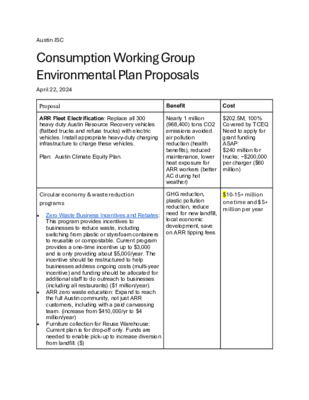5. Proposed Environmental Investment Plan Consumption Recommendations — original pdf
Backup

Benefit Cost $202.5M, 100% Covered by TCEQ Need to apply for grant funding ASAP: $240 million for trucks; ~$200,000 per charger ($60 million) $10-15+ million one time and $5+ million per year Nearly 1 million (968,400) tons CO2 emissions avoided. air pollution reduction (health benefits), reduced maintenance, lower heat exposure for ARR workers (better AC during hot weather) GHG reduction, plastic pollution reduction, reduce need for new landfill, local economic development, save on ARR tipping fees Consumption Working Group Environmental Plan Proposals Austin JSC April 22, 2024 Proposal ARR Fleet Electrification: Replace all 300 heavy duty Austin Resource Recovery vehicles (flatbed trucks and refuse trucks) with electric vehicles. Install appropriate heavy-duty charging infrastructure to charge these vehicles. Plan: Austin Climate Equity Plan. Circular economy & waste reduction programs • Zero Waste Business Incentives and Rebates: This program provides incentives to businesses to reduce waste, including switching from plastic or styrofoam containers to reusable or compostable. Current program provides a one-time incentive up to $3,000 and is only providing about $5,000/year. The incentive should be restructured to help businesses address ongoing costs (multi-year incentive) and funding should be allocated for additional staff to do outreach to businesses (including all restaurants) ($1 million/year). • ARR zero waste education: Expand to reach the full Austin community, not just ARR customers, including with a paid canvassing team. (increase from $410,000/yr to $4 million/year) • Furniture collection for Reuse Warehouse: Current plan is for drop-off only. Funds are needed to enable pick-up to increase diversion from landfill. ($) • Deconstruction Warehouse: To divert salvaged construction materials from the landfill. ($10-15 million) • Fix-it Clinics: Expand and host more ($500,000/year), • Circular Austin Accelerator and Circular Austin Showcase competition: Expand outreach and an increased number and value of awards for competition winners would increase effectiveness in building a circular economy in Austin. (increase from $ to $); • MoveOutATX: Increase number of events (increase from $/year to $/year); Plan: Austin Resource Recovery Comprehensive Plan & Austin Climate Equity Plan (Food and Product Consumption Goal 2, Strategy 4) Low-carbon concrete fund: Concrete represents the largest of Austin’s purchasing emissions, with potential surcharges for truly carbon neutral cement ranging as high as an additional $18/cubic yard, but with costs falling as new technology scales up. This fund would pay for additional testing, program fees, and surcharges to cover both city and non-city owned buildings of 1.1 M cubic yards of concrete. Plan: Austin Climate Equity Plan. Pro-climate, pro-health foods: Replacing animal products with plant-based foods is one of the most cost effective ways to reduce GHG emissions. Funds would be used to provide education and incentives to the Austin community to enable better choices. Plan: Austin Climate Equity Plan & Austin/Travis County Food Plan. Sustainable purchasing and carbon accounting : Austin can’t get to net-zero without measuring our progress. Today, staff make tradeoffs between doing the work and accounting for that work. Additional staff, consultant, and software money can add capacity and speed up this critical work. Plan: Austin Climate Equity Plan GHG reduction: 200,000 MT of CO2/year $2 million/year $500,000/year GHG reduction, air and water pollution reduction, water use reduction, improved public health Unlocks GHG reduction $1 million ARR Transfer Station: a transfer station to host electric truck chargers is necessary to enable full ARR fleet electrification Plan: Austin Resource Recovery Comprehensive Plan, Austin Climate Equity Plan Unlocks GHG and air pollution reduction from transportation electrification ~$100 million GHG reduction, air pollution reduction, reduced costs: 66,130 MT CO2E ( 1.3 MT CO2E/ton of feedstock) $1.5M for startup costs with savings of $1,222,980 / year for 51,000 tons of waste City-owned composting facility: Emissions from Austin’s waste like methane and nitrous oxide decay quickly in the atmosphere, but have a large short-term impact. Looking at waste using 20-year global warming potential puts landfill waste as our 3rd largest source of emissions (right behind energy & transport), or well over 1 million metric tons of CO2e. Purchasing and operating a municipal composting facility will help avoid the landfilling of organic waste and save money. Plan: Austin Climate Equity Plan